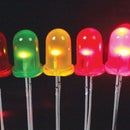Introduction: A Step by Step Tutorial to Get Started With STM32 Black Pill and STM Cube IDE to Blink External Connected LED Using HAL Programming.
Hello, this is a blog that gives you a step by step tutorial to get started with STM32 black pill and STM cube IDE to blink
external connected LED using HAL programming.
Supplies
- STM32 black pill board with in-built LED
- USB –Type C cable
- LED
- Bread-board
Step 1: Setting Up STM32CubeIDE
- Download and install STM32CubeIDE from the STMicroelectronics website.
- Launch STM32CubeIDE.
- Create a new STM32 project by selecting File > New > STM32 Project.
Step 2: Setting Up Project
- Enter a project name and choose a location to save your project.
- Select the appropriate toolchain (e.g., Ac6 STM32 MCU GCC) and click "Next."
- Configure the project settings such as HAL, CMSIS, and middleware. For this tutorial, we will leave the default settings.
- Click "Finish" to create the project.
Step 3: Building and Flashing the Firmware
- Build the project by clicking on the hammer icon in the toolbar.
- Connect your STM32 Black Pill board to your computer via USB.
- Flash the firmware by clicking on the lightning bolt icon in the toolbar.
Step 4: Hardware Setup
- Connect the LED to the breadboard.
- Connect one leg of the LED to PC13 pin of the STM32 Black Pill board via a resistor.
- Connect the other leg of the LED to the ground (GND) pin of the STM32 Black Pill board.
Step 5: Testing
- Power on the STM32 Black Pill board.
- The LED should start blinking at a 1-second interval.
- The STM32 Black Pill is successfully set up and programmed to blink the external LED using HAL Programming.










![Tim's Mechanical Spider Leg [LU9685-20CU]](https://content.instructables.com/FFB/5R4I/LVKZ6G6R/FFB5R4ILVKZ6G6R.png?auto=webp&crop=1.2%3A1&frame=1&width=306)


